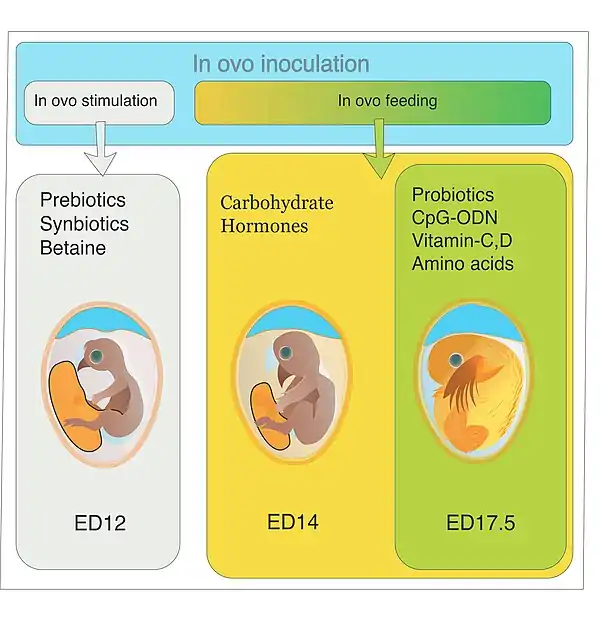
In ovo is Latin for in the egg. In medical usage it refers to the growth of live virus in chicken egg embryos for vaccine development for human use, as well as an effective method for vaccination of poultry against various Avian influenza and coronaviruses. During the incubation period, the virus replicates in the cells that make up the chorioallantoic membrane.[2][3]
Advantages
In human vaccine development, the main advantage is rapid propagation, and high yield, of viruses for vaccine production. This method is most commonly used for growth of influenza virus, both attenuated vaccine and inactivated vaccine forms. It is recommended by the World Health Organization in managing influenza pandemics because it is high-yield and cost effective. [3]
In poultry, In ovo vaccination improves hatchability and efficient protection against Avian influenza (AI), Newcastle disease (ND) and Coronaviruses (Av-CoV). Seroconversion rates of chickens vaccinated as embryos ranged from 27% to 100% with ND vaccination and 85% to 100% for AI vaccination. The birds are protected before delivery to a commercial operation such as a farm, thus preventing the spread of Avian viruses.[4][5]
Vaccination
In ovo vaccination is carried out by machines. These machines perform a number of actions to ensure good vaccination of the chick inside the egg. Benefits of In ovo vaccination include avoidance of bird stress, controlled hygienic conditions, and earlier immunity with less interference from maternal antibodies. [6]
Feeding

In ovo feeding is a considered as a potential tool to provide nutrient to embryo as well as to modulate performance and gut health of pre and post hatched chicks.[1] Based on the purpose the in ovo injection could be considered as in ovo stimulation or in ovo feeding.[1]
See also
References
- 1 2 3 4 Das, Razib; Mishra, Pravin; Jha, Rajesh (2021-11-11). "In ovo Feeding as a Tool for Improving Performance and Gut Health of Poultry: A Review". Frontiers in Veterinary Science. 8: 754246. doi:10.3389/fvets.2021.754246. ISSN 2297-1769. PMC 8632539. PMID 34859087.
- ↑ Ricks CA, Avakian A, Bryan T, Gildersleeve R, Haddad E, Ilich R, et al. (1999). "In ovo vaccination technology". Advances in Veterinary Medicine. 41: 495–515. doi:10.1016/S0065-3519(99)80037-8. PMID 9890038.
- 1 2 Hickling J, D'Hondt E (December 2006). "A review of production technologies for influenza virus vaccines, and their suitability for deployment in developing countries for influenza pandemic preparedness" (PDF). World Health Organization Initiative for Vaccine Research. pp. 1–34. Archived from the original (PDF) on 2010-10-08.
- ↑ Cai Y, Song H, Ye J, Shao H, Padmanabhan R, Sutton TC, Perez DR (January 2011). "Improved hatchability and efficient protection after in ovo vaccination with live-attenuated H7N2 and H9N2 avian influenza viruses". Virology Journal. 8: 31. doi:10.1186/1743-422X-8-31. PMC 3032716. PMID 21255403.
- ↑ Stone H, Mitchell B, Brugh M (1997). "In ovo vaccination of chicken embryos with experimental Newcastle disease and avian influenza oil-emulsion vaccines". Avian Diseases. 41 (4): 856–863. doi:10.2307/1592339. JSTOR 1592339. PMID 9454919.
- ↑ "In-Ovo Vaccination: Benefits for Small Hatcheries". The Poultry Site.